I was right. There have been a number of great new manga series this year. A cursory glance at some of the new volumes included in this week’s ComicList proves it.
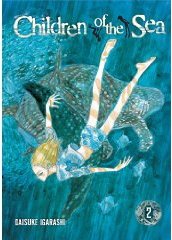 The founder of the feast this week’s is Viz’s Signature imprint, which leads things off with the second volume of Daisuke Igarashi’s Children of the Sea. It’s easily one of the most beautiful comics you’ll read this year, and Igarashi seems to be building an interesting contemporary fable about mysterious children and disappearing fish. You can read it online for free at Viz’s SIGIKKI site, but I like holding the actual object. Also, if lots of people buy Children of the Sea, we might get Igarashi’s Witches sometime in the future.
The founder of the feast this week’s is Viz’s Signature imprint, which leads things off with the second volume of Daisuke Igarashi’s Children of the Sea. It’s easily one of the most beautiful comics you’ll read this year, and Igarashi seems to be building an interesting contemporary fable about mysterious children and disappearing fish. You can read it online for free at Viz’s SIGIKKI site, but I like holding the actual object. Also, if lots of people buy Children of the Sea, we might get Igarashi’s Witches sometime in the future.
 Please don’t misunderstand me. I think Naoki Urasawa’s Pluto is a fine comic in every respect, easily one of the best of the year. It’s a wonderfully constructed thriller with a higher-than-average number of important things on its mind. I admire it tremendously, I really do. But I love Urasawa’s 20th Century Boys with its twists and turns, healthy doses of humor and wistfulness, and its energetic quirkiness. I also think it’s one of the best comics of the year, and the fact that it’s more… well… fun than Pluto pushes it just a note higher on my personal scale. The sixth volume of 20th Century Boys arrives this week.
Please don’t misunderstand me. I think Naoki Urasawa’s Pluto is a fine comic in every respect, easily one of the best of the year. It’s a wonderfully constructed thriller with a higher-than-average number of important things on its mind. I admire it tremendously, I really do. But I love Urasawa’s 20th Century Boys with its twists and turns, healthy doses of humor and wistfulness, and its energetic quirkiness. I also think it’s one of the best comics of the year, and the fact that it’s more… well… fun than Pluto pushes it just a note higher on my personal scale. The sixth volume of 20th Century Boys arrives this week.
 I’m still not entirely sure why the phrase “Fumi Yoshinaga’s most ambitious work to date” doesn’t make people lift their heads like deer becoming aware of a mighty predator crashing through the forest. Even her lighthearted comics have an enduring quality that’s kind of rare in mainstream entertainment. So I’m a little disappointed that Yoshinaga’s Ôoku: The Inner Chambers hasn’t cast a wider net among critics. Yes, bits of the translation are awkward, but for my money, there are few finer working cartoonists than Yoshinaga, and the opportunity to enjoy the acclaimed apex of her career to date is just so damned cool. The second volume of Ôoku graces better comic shops on Wednesday.
I’m still not entirely sure why the phrase “Fumi Yoshinaga’s most ambitious work to date” doesn’t make people lift their heads like deer becoming aware of a mighty predator crashing through the forest. Even her lighthearted comics have an enduring quality that’s kind of rare in mainstream entertainment. So I’m a little disappointed that Yoshinaga’s Ôoku: The Inner Chambers hasn’t cast a wider net among critics. Yes, bits of the translation are awkward, but for my money, there are few finer working cartoonists than Yoshinaga, and the opportunity to enjoy the acclaimed apex of her career to date is just so damned cool. The second volume of Ôoku graces better comic shops on Wednesday.
 I’m finally getting used to actually looking at Image’s listings, since they’re publishing some comics I’m really enjoying. (I thought I’d never have to do that again after they gave up on Glister. Who knew?) This week, it’s the fourth issue of spelunking thriller Underground, written by Jeff Parker, illustrated by Steve Leiber, and colored by Ron Chan. A determined ranger tries to protect a pristine cave from an unscrupulous developer and his well-armed minions.
I’m finally getting used to actually looking at Image’s listings, since they’re publishing some comics I’m really enjoying. (I thought I’d never have to do that again after they gave up on Glister. Who knew?) This week, it’s the fourth issue of spelunking thriller Underground, written by Jeff Parker, illustrated by Steve Leiber, and colored by Ron Chan. A determined ranger tries to protect a pristine cave from an unscrupulous developer and his well-armed minions.
 Oh, and while I’m not following the series myself, manga karma points must go to Del Rey for its rescue of Akimine Kimiyo’s Samurai Deeper Kyo. For those of you who don’t remember, Tokyopop had reached the thirty-fourth volume of this thirty-eight volume series before Kodansha reclaimed rights to all of its properties from Tokyopop. Lest its fans become profoundly (and understandably) embittered by that turn of events so close to the finish line, Del Rey is publishing two-volume collections of the final six volumes, the first of which arrives Wednesday.
Oh, and while I’m not following the series myself, manga karma points must go to Del Rey for its rescue of Akimine Kimiyo’s Samurai Deeper Kyo. For those of you who don’t remember, Tokyopop had reached the thirty-fourth volume of this thirty-eight volume series before Kodansha reclaimed rights to all of its properties from Tokyopop. Lest its fans become profoundly (and understandably) embittered by that turn of events so close to the finish line, Del Rey is publishing two-volume collections of the final six volumes, the first of which arrives Wednesday.
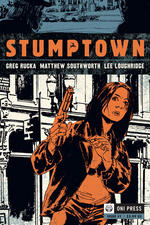
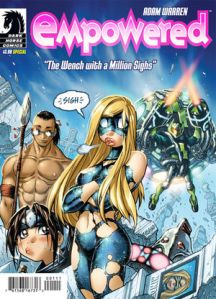









 It’s tough to pick a book of the week, as there’s interesting material in varied formats, but I ultimately have to settle on
It’s tough to pick a book of the week, as there’s interesting material in varied formats, but I ultimately have to settle on  Now, don’t get me wrong. I’m a fan of the books in Viz’s Signature line and an admirer of the imprint in general. I honestly can’t think of one I don’t at least enjoy. That said I do question the wisdom of unleashing quite this much product on the market at once. In addition to the aforementioned volume of Real, there’s
Now, don’t get me wrong. I’m a fan of the books in Viz’s Signature line and an admirer of the imprint in general. I honestly can’t think of one I don’t at least enjoy. That said I do question the wisdom of unleashing quite this much product on the market at once. In addition to the aforementioned volume of Real, there’s 
 I enjoyed
I enjoyed 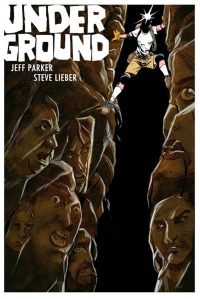 I find it harder to review pamphlet comics, since there’s less content to consider, but
I find it harder to review pamphlet comics, since there’s less content to consider, but 
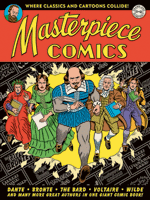 There are two arrivals that can be described as clever ideas executed extremely well. R. Sikoryak’s
There are two arrivals that can be described as clever ideas executed extremely well. R. Sikoryak’s  Viz releases many, many books this week, some of which will very likely show up on the Graphic Book Best Seller List over at The New York Times, but my attention is fixated on the second volume of
Viz releases many, many books this week, some of which will very likely show up on the Graphic Book Best Seller List over at The New York Times, but my attention is fixated on the second volume of 




 But today’s title is actually an independent work Smith did with James Robinson for Image: Leave it to Chance. It ran for a mere thirteen issues, but it was really terrific while it lasted. I like
But today’s title is actually an independent work Smith did with James Robinson for Image: Leave it to Chance. It ran for a mere thirteen issues, but it was really terrific while it lasted. I like  There are some debuts. I quite liked the first volume of Natsuna Kawase’s The Lapis Lazuli Crown (CMX), so I’ll certainly take a chance on
There are some debuts. I quite liked the first volume of Natsuna Kawase’s The Lapis Lazuli Crown (CMX), so I’ll certainly take a chance on  I’ve enjoyed Josh Neufeld’s travel comics, though he tends to go places I would never personally consider for a vacation. My idea of roughing it is hotels with limited room service. But his
I’ve enjoyed Josh Neufeld’s travel comics, though he tends to go places I would never personally consider for a vacation. My idea of roughing it is hotels with limited room service. But his 
Quick pamphlet comments
I’m very pleased that Image and Tokyopop are reprinting Brandon Graham’s King City in pamphlet form. In spite of good reviews, I missed it in digest form. While I don’t have a basis for comparison, I suspect it’s better served in its new, full-sized format than it might have been in tankoubon size. There are lots of little thing to look at, and the bigger page size seems friendlier to that.
Here’s an example of a layout that I really liked from the second issue.
At this point, I know very little about the characters above, but that panel makes me really interested in both of them. Graham’s pages generally have interesting layouts, and there’s a nice sense of motion and bustle to a lot of them, but he also has a nice handle on little gradations of facial expression and body language. He really sells moments like these.
As you would expect from the title, there’s also a nice sense of place. King City, the setting, evokes that kind of sleazy modernism that a lot of creators attempt but don’t necessarily achieve. I think that’s because Graham is judicious about the way he reveals things. He hasn’t front-loaded the city’s entire culture, choosing instead to put it out there a bit at a time, making me curious about what things mean and what they’ll amount to later. That’s probably another reason why it’s a good fit with pamphlet publication. An individual issue constitutes a satisfying chunk, a nice monthly visit to a weird place and the intriguing characters that live there.
My purchase of two other comics – Marvel Divas and Models, Inc. – is driven by a combination of nostalgia and a reflexive desire to promote diversity. When I dropped Marvel comics entirely, there were no titles like this, lighthearted and driven by women characters. So my activist streak kicked in and I decided to give them at least one more sale.
I prefer Divas (written by Roberto Aguirre-Sacasa, drawn and inked by Tonci Zonjic, and colored by Jelena Kevic-Djurdjevic). It’s about four c-list super-heroines who hang out and support each other through their various woes. Pretty much every one of those woes has been portrayed in a more straightforward manner in episodes of Sex and the City, right down to cancer, but Aguirre-Sacasa finds nice spandex twists on the subject matter. And while I’ll never be convinced of the wisdom of mixing real-world illness in a setting where characters can banish it with a wave of their hand (or can’t, depending on the demands of the plot), there’s a surprising amount of nuance in the scenes where young heroine Firestar copes with her illness with the help of her more seasoned cast-mates. It’s not a great comic, and it doesn’t track with its own marketing even a little, but it’s got some solid, character-driven writing that doesn’t condescend to the characters. Aguirre-Sacasa creates a plausible, endearing support system among the four women, which is nice to see.
Models, Inc. (written by Paul Tobin, drawn and inked by Vicenc Villagrasa, colored by Val Staples, and lettered by Dave Sharpe) is what is what might be known in the rag trade as “a hot mess.” It unfolds during Fashion Week, with one of Marvel’s model characters (Millie) accused of murder. It’s up to her friends (other Marvel model characters) to clear her of the crime. I like lighthearted mysteries as much as or more than the next person, but this one is hobbled by the fact that almost none of the characters make any specific impression. There are at least two models two many, and they seem to have been selected entirely for visual variety rather than anything specific they bring to the story. The closest thing to a breakout character would be bisexual Chili Storm, who at least gets to be a bit of a spitfire and isn’t limited to spouting exposition or being blandly supportive, though she also carries water from those wells.
Another difficult is that the look of the book isn’t especially fashionable. I can’t say that I follow fashion beyond trying to catch episodes of Project Runway, but I get a distinctly dowdy and dated vibe from the cast’s wardrobe. I suspect Villagrasa is going for a detached, posing style in his compositions – as if the models are always at least a little aware that there’s a camera pointed at them – and it’s not a bad idea, but the execution doesn’t really work. (And yes, I know that the panels above show them actually posing, but what the hell are they wearing?) It doesn’t go far enough, so it ends up looking sort of weird.
I did love the Tim Gunn back-up story in the first issue (written by Marc Sumerak, drawn by Jorge Molina). Runway mentor Gunn saves the day with style, which is what I was hoping for from the lead story. Alas, Models, Inc. is more a meeting of a catwalk Girl Scout troop.